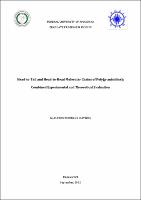| ???jsp.display-item.social.title??? |


|
Please use this identifier to cite or link to this item:
https://tede.ufam.edu.br/handle/tede/9413| ???metadata.dc.type???: | Tese |
| Title: | Head-to-Tail and Head-to-Head Molecular Chains of Poly(p-anisidine): Combined Experimental and Theoretical Evaluation |
| ???metadata.dc.creator???: | Oliveira, Lilian Rodrigues de  |
| ???metadata.dc.contributor.advisor1???: | Sanches, Edgar Aparecido |
| ???metadata.dc.contributor.referee1???: | Mascarenhas, Yvonne Primerano |
| ???metadata.dc.contributor.referee2???: | Facchinatto, William Marcondes |
| ???metadata.dc.contributor.referee3???: | Frota, Hidembergue Ordozgoith da |
| ???metadata.dc.contributor.referee4???: | Fonseca Filho, Henrique Duarte da |
| ???metadata.dc.description.resumo???: | Poly(p–anisidine) (PPA) is a polyaniline presenting a methoxy (–OCH3) group at the para position of the phenyl ring. Considering the important role of conjugated polymers in novel technological applications, a systematic, combined experimental and theoretical investigation had been performed to get more insight into the crystallization process of PPA. Conventional oxidative polymerization of p–anisidine monomer was based on a Central Composite Rotational Design (CCRD). The effect of the concentration of the monomer, ammonium persulfate (APS) and HCl on the percentage of crystallinity was considered. Several experimental techniques such as X-Ray diffraction (XRD), Scanning Electron Microscopy (SEM), Multifractal Analysis, Nuclear Magnetic Resonance (13C NMR), Fourier-transform Infrared Spectroscopy (FTIR), Complex Impedance Spectroscopy analysis besides Density Functional Theory (DFT) were employed to perform a systematic investigation of PPA. The experimental treatments resulted in different crystal structures with the percentage of crystallinity ranging from (29.2 ± 0.6) % (PPA1HT) to (55.1 ± 0.2) % (PPA16HT-HH). The XRD patterns of PPA1HT and PPA16HT-HH were clearly correlated, but more defined in PPA1HT. A broad hallo in the PPA16HT-HH pattern from 2θ = 10.0° – 30.0° suggested reduced crystallinity. Basically, two types of morphology were observed in both samples: needles and globular particles. SEM images suggested that the needles morphology might be related to the crystalline contribution. Multifractal analysis showed that the PPA surface became more irregular and complex when the crystallinity was reduced. The proposed molecular structures of PPA were supported by the high-resolution 13C NMR results, allowing to access the percentage of head–to–tail (HT) and head–to–head (HH) molecular structures: PPA1HT was fully (100%) constituted of HT polymer chains (PPAHT), while PPA16 was formed predominantly by HT molecular structure [(62.0 ± 0.5) %; PPAHT-HH). Comparing calculated and experimental FTIR spectra, the most pronounced changes were observed in ν(C–H), ν(N–H), ν(C–O) and ν(C–N–C) due to the influence of counter ions, as well as by the different mechanisms of polymerization. Finally, a significant difference in electrical conductivity values was observed in the range of 1.00 x 10-9 S.cm-1 and 3.90 x 10-14 S.cm-1, respectively, for PPA1HT and PPA16HT-HH. |
| Abstract: | A poli(p–anisidina) (PPA) é uma polianilina que apresenta um grupo metoxi (–OCH3) na posição para do anel fenil. Considerando o importante papel dos polímeros conjugados em aplicações tecnológicas, uma investigação sistemática combinando dados experimentais e teóricos foi realizada para obter mais informações sobre o processo de cristalização da PPA. A polimerização oxidativa convencional do monômero p-anisidina foi baseada em um projeto rotacional composto central (CCRD). Foi considerado o efeito da concentração do monômero, persulfato de amônio (APS) e HCl no percentual de cristalinidade. Técnicas experimentais como Difração de Raios X (DRX), Microscopia Eletrônica de Varredura (MEV), Análise Multifractal, Ressonância Magnética Nuclear (RMN 13C), Espectroscopia no Infravermelho por Transformada de Fourier (FTIR), Espectroscopia de Impedância Complexa, além da Teoria do Funcional da Densidade (DFT) foram empregados para realizar uma investigação sistemática da PPA. Os tratamentos experimentais resultaram em diferentes estruturas cristalinas com porcentual de cristalinidade variando de (29,2 ± 0,6) % (PPA1HT) a (55,1 ± 0,2) % (PPA16HTHH). Os padrões de DRX de PPA1HT e PPA16HT-HH foram claramente correlacionados, mas mais definidos para PPA1HT. Um amplo halo no padrão da PPA16HT-HH de 2θ = 10,0° – 30,0° sugeriu cristalinidade reduzida. Basicamente, dois tipos de morfologia foram observados em ambas as amostras: agulhas e partículas globulares. As imagens de MEV sugeriram que a morfologia das agulhas pode estar relacionada com a contribuição cristalina. A análise multifractal mostrou que a superfície do PPA se tornou mais irregular e complexa quando a cristalinidade foi reduzida. As estruturas moleculares propostas da PPA foram correlacionadas com os resultados de RMN 13C de alta resolução, permitindo acessar o percentual de estruturas moleculares cabeça-cauda (HT) e cabeça-cabeça (HH): PPA1HT foi totalmente (100%) constituída por cadeias poliméricas HT, enquanto a PPA16 foi formada predominantemente por estrutura molecular HT [(62,0 ± 0,5) %. Comparando os espectros de FTIR calculados e experimentais, as mudanças mais pronunciadas foram observadas em ν(C–H), ν(N–H), ν(C–O) e ν(C–N–C) devido à influência dos contra-íons dopantes, bem como pelos diferentes mecanismos de polimerização. Por fim, foi observada uma diferença significativa nos valores de condutividade elétrica na faixa de 1,00 x 10-9 e 3,90 x 10-14 S.cm-1, respectivamente, para PPA1HT e PPA16HT-HH. |
| Keywords: | Matéria condensada Polímeros Polímeros condutores |
| ???metadata.dc.subject.cnpq???: | CIENCIAS EXATAS E DA TERRA: FISICA: FISICA DA MATERIA CONDENSADA |
| ???metadata.dc.subject.user???: | Poly(p–anisidine) Conjugated polymer DFT Head-to-tail Head-to-head Multifractal analysis |
| Language: | eng |
| ???metadata.dc.publisher.country???: | Brasil |
| Publisher: | Universidade Federal do Amazonas |
| ???metadata.dc.publisher.initials???: | UFAM |
| ???metadata.dc.publisher.department???: | Instituto de Ciências Exatas |
| ???metadata.dc.publisher.program???: | Programa de Pós-graduação em Física |
| Citation: | OLIVEIRA, Lilian Rodrigues de. Head-to-Tail and Head-to-Head Molecular Chains of Poly(p-anisidine): Combined Experimental and Theoretical Evaluation. 2022. 88 f. Thesis (Doctorate in Physics) - Federal University of Amazonas, Manaus (AM), 2022. |
| ???metadata.dc.rights???: | Acesso Aberto |
| ???metadata.dc.rights.uri???: | http://creativecommons.org/licenses/by-nc-nd/4.0/ |
| URI: | https://tede.ufam.edu.br/handle/tede/9413 |
| Issue Date: | 9-Sep-2022 |
| Appears in Collections: | Doutorado em Física |
Files in This Item:
| File | Description | Size | Format | |
|---|---|---|---|---|
| Tese_LilianOliveira_PPGFIS.pdf | 3.53 MB | Adobe PDF |  Download/Open Preview |
This item is licensed under a Creative Commons License





